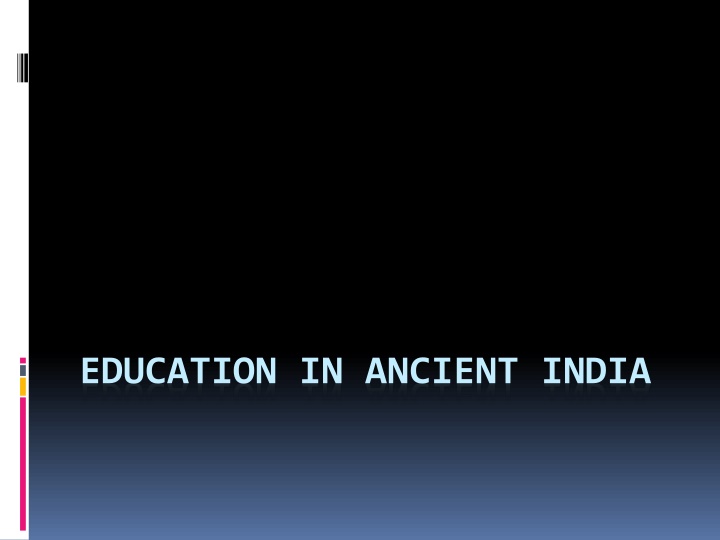
Ancient Indian Education Systems and Practices
Explore the rich history of education in ancient India, spanning from the Vedic period to post-independence eras. Discover the aims, methods of teaching, evaluation systems, and main features of education during different historical periods.
Download Presentation

Please find below an Image/Link to download the presentation.
The content on the website is provided AS IS for your information and personal use only. It may not be sold, licensed, or shared on other websites without obtaining consent from the author. If you encounter any issues during the download, it is possible that the publisher has removed the file from their server.
You are allowed to download the files provided on this website for personal or commercial use, subject to the condition that they are used lawfully. All files are the property of their respective owners.
The content on the website is provided AS IS for your information and personal use only. It may not be sold, licensed, or shared on other websites without obtaining consent from the author.
E N D
Presentation Transcript
History of Indian Education Pre-independence Post independence Vedic period(before 600 B.C) Buddhist period(600BC- 1200AD) Medieval or Muslim period(1200AD-1800AD) British period(1800AD- 1947) After 1947 to till date
Education system in Vedic period
Sources of Vedic period Four Vedas: (the Rig-Veda, Sama-Veda, Yajur- Veda, and Atharva-Veda) Six vedangas: (Shiksha ( ik ): phonetics, phonology, pronunciation. ... Chandas (chandas): prosody. ... Vyakarana (vy kara a): grammar and linguistic analysis. ... Nirukta (nirukta): etymology, explanation of words, particularly those that are archaic and have ancient uses with unclear meaning. ... Kalpa (kalpa): ritual instructions. Jyotisha (jyoti a)
Four upavedas: The Charanavyuhamentions four Upavedas: Archery (Dhanurveda), associated with the Yajurveda. Architecture (Sthapatyaveda), associated with the Atharvaveda. Music and sacred dance (G ndharvaveda), associated with the Samaveda. Four Brahmanas: 180 Upanishads Six system of philosophy: (These include six systems ( a dar ana) Sankhya, Yoga, Nyaya, Vaisheshika, Mimamsaand Vedanta) BhagwatGita. Three Smrities.
Aims and objectives of Vedic education Ultimate objective as Moksha or self realisation. Character formation. Development of all round personality: a) self confidence b) self restraint c) self respect d) discrimination and judgment. Stress on social duties Promotion of social efficiency Preservation and promotion of culture.
Main features of Vedic period Free education in ancient India. No state control on education. High status of teacher. Teacher as parents. Residential school. Immediate aim (vocational): the immediate aim of education, however as to prepared the different cast of people for actual need
Method of teaching Sravana Manana Nididhyasana Individual teaching
Evaluation system Maha prazanan grade: (students very high ability) Madhyama prazanan grade: (high ability) Alpo prazanan grade: (low ability)
Medium of instruction: Sanskrit. Self control and self discipline. Wide spread education of woman. Teacher as the spiritual as wel as intellectual guide
curriculum Anthropology Astronomy Economics Epistemology Eschalogy Ethnology Geology Mathematics Military science Human eugenics
Weakness of Vedic education Strict discipline Immense importance of religion Lack of freedom of thought Hatred for religion
